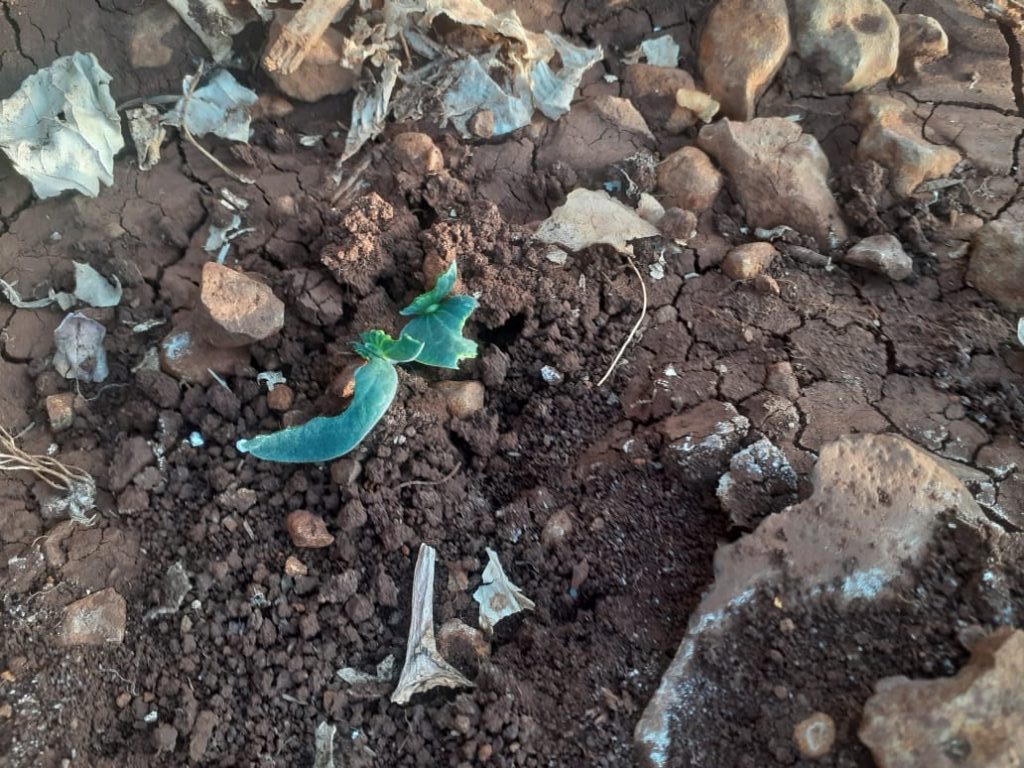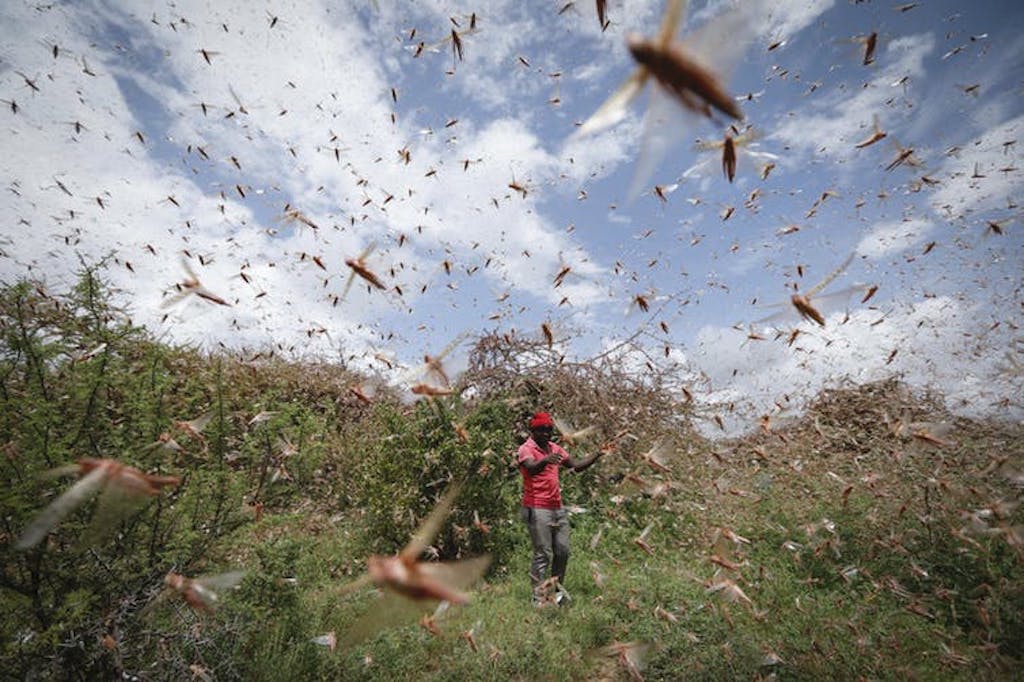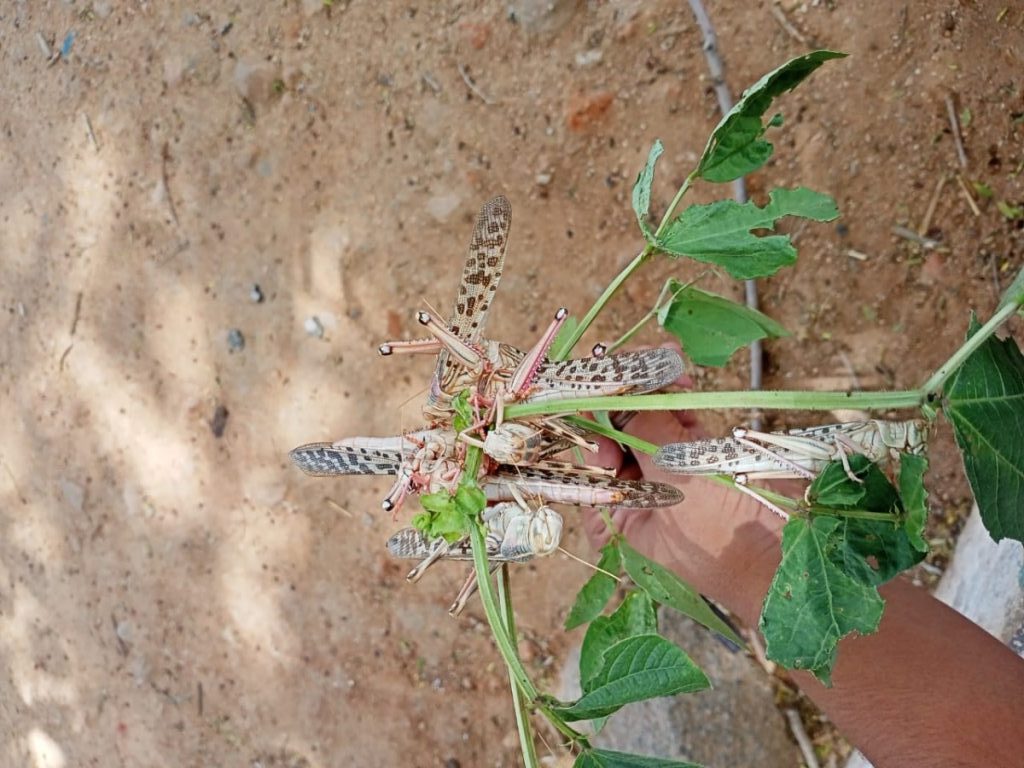11 Mins Read
By: Kabir Agarwal & Shruti Jain
The attack is a highly irregular one, say experts. Farmers on the field feel that the measures taken were too little and too late.
Large swarms of desert locusts have entered areas in India where they had not been seen since 1993 and have already caused damage to crops in Rajasthan, Gujarat, Madhya Pradesh, parts of Uttar Pradesh and Maharashtra.
The migratory pest has made several incursions into Rajasthan in the last two decades – including a significant one last year. But this time, the swarms have spread to parts of Madhya Pradesh, Uttar Pradesh and even Maharashtra.
Locusts last swarmed Madhya Pradesh and Uttar Pradesh in 1993 and have not been seen since 1974 in Maharashtra.
A swarm reached the city of Jaipur on Monday, as urban residents commented on Twitter that 2020 might be the “last year for humankind”.
The real damage, however, is being caused and will be caused in rural India where farmers already bearing the brunt of the COVID-19 induced lockdown and the low prices they have fetched in the last few years, stare at massive crop damage that the locust swarms are capable of inflicting.
According to the Food and Agricultural Organisation (FAO) of the United Nations, a swarm of locusts spread across an area of one square kilometre can eat as much food as 35,000 people in one day. Their appetite is voracious and one locust can consume food equal to its own weight – about two grams – on a daily basis. And since a square kilometre swarm would contain about 40 million locusts, it can cause a significant amount of damage in a short period of time.
‘Too late’
Sooraj Pandey, a farmer in Mhow near Indore in Madhya Pradesh, witnessed this damage first-hand.
He told us over the phone that he was in his house when the tiddi dal (locust swarm) attacked his farm on May 23. A worker on his farm called him and said that ‘insects’ had spread across the farm.

“I knew these weren’t normal insects. I ran. As soon as I reached, I realised that this is the tiddi dal. We quickly took out our tractor to drive them away. We tried banging utensils to scare them with the sound,” he said.
But it was too little and too late. The locusts had polished off about half the pumpkin that was growing on his 4-acre field. “They ate like they hadn’t eaten for months. Everything was gone, only shoots were left,” said Pandey.
More than 500 kilometres from Mhow, a locust swarm also attacked Akhilesh Litoria’s farm in Jhansi, Uttar Pradesh. “It looked like someone had placed a huge white sheet on top of the entire field,” he told us over the phone. According to Litoria, the swarm of locusts that attacked fields in Jhansi on May 24 was spread over an area of one square kilometre.
“They finished the entire crop in the area. We had planted moong and they ate all of it. They did not even spare leaves on trees. Some of them sat on trees and ate all the leaves,” said Litoria.
The moong crop was also damaged 500 kilometres south of Jhansi, in Harda. Anand Patel has around 10 acres of land and about half his moong crop was eaten by a locust swarm. “They are not scared of anything. We tried banging utensils, rode motorcycles without silencers. But they remained there and finished off the crop,” Patel said.
According to a report in Times of India, locust swarms have reached as far as Vidarbha in Maharashtra and caused crop damage. This, according to the report, has not happened since 1974.
All three farmers quoted here and a few others we spoke to said that they haven’t seen a locust attack such as this one in their lives. “Even my father, who is 86, said he hasn’t ever seen anything like this. Only heard about this in folk tales,” said Pandey, who is 64.
‘Irregular’
According to the government of India’s Locust Warning Organisation (LWO), the attack this year is highly irregular as it has come earlier than usual and reached farther. “This time the locusts have come in May. That almost never happens. Maybe they got more fertile breeding ground this season,” said K.L. Gurjar, deputy director at the directorate of plant protection, quarantine and storage.
Favourable conditions for desert locusts to breed consists of moist sand and green vegetation in arid areas. These favourable conditions were made available to the locusts in the desert region of Africa and Arabian Peninsula due to heavy rainfall that the region witnessed in 2019. They then migrated to India via Iran and Pakistan.
According to Roxy Mathew Koll, climate scientist at Indian Institute of Tropical Meteorology, the heavy rainfall was caused by unusually warm waters in the western Indian Ocean in late 2019. And the unusually warm waters were caused by climate change or global warming.
“These warm waters were caused by the phenomenon called the Indian Ocean Dipole — with warmer than usual waters to its west, and cooler waters to its east. Rising temperatures due to global warming amplified the dipole and made the western Indian Ocean particularly warm,” Koll explained over email.
In addition to the creation of a fertile breeding ground in parts of Africa and the Arabian peninsula, the locust swarms may have also been encouraged into India due to the heavy pre monsoon rain that we have witnessed this season.
Usually, locust swarms would be expected to enter the arid area of Rajasthan in India from Pakistan around the onset of monsoon. But this year, locusts had been reported as early as April, in parts of Rajasthan and Punjab.
This early migration of locusts could be a consequence of excessive pre-monsoon rain in about 70% of India, according to Koll. “Heavy rain triggers the growth of vegetation in arid areas where desert locusts can then grow and breed. These locusts which migrated to India early this year might have found greener pastures as the pre-monsoon rains during March-May were in excess over north India this year,” he said.

Western disturbances
The increased pre-monsoon rains have in turn been caused by another unusual weather pattern. The excess pre monsoon rains have, in large part, been caused by the increased frequency of western disturbances (WD) – which are low pressure systems that originate in the Mediterranean Sea or mid-west Atlantic Ocean, move eastwards and are the cause of most of north western India’s pre monsoon rain.
“Every year during December to March-April, an average of 4–6 western disturbances (WD) per month reach India. This year we had a larger than usual number of WDs active over India. So, this might have partially contributed to the excess pre-monsoon rains,” Koll said.
Secretary of the Union Ministry of Earth Sciences, M. Rajeevan, told Gaon Connection recently that the WDs this season even extended beyond north India into central and southern India.
Scientists have also said that the increased WD activity this season could have a polar connection and be linked to the polar vortex – a low pressure system of extremely cold swirling air in the north and south poles.
“The large-scale cyclonic activity associated with the polar vortex can trigger different circulation patterns towards the lower latitudes. Storms in the UK this winter have also been linked to the polar vortex,” R.K. Jenamani, senior scientist at National Weather Forecasting Centre told Jayshree Nandi of the Hindustan Times in March.
D.S. Pai, senior scientist at the India Meteorological Department, concurred and told the English daily that the polar vortex can impact mid-latitude westerlies and be a cause for increased WDs in India.
However, it has not yet been conclusively established whether the increased incidence of WDs is a long-term change in climate and if yes, then whether that change has been brought about by global warming. This is something that all the scientists mentioned here are working on.
Keith Cressman, Senior Locust Forecasting Officer at the FAO, also sees a longer term trend of increasing cyclone activity in the Indian Ocean leading to heavy rains in Arabian peninsula and parts of Africa, and that is, in turn, leading to more desert locust upsurges.
“There were eight cyclones in 2019 when in most years there are only one or two. Three cyclones in 2018 and two in 2019 have contributed to the current desert locust upsurge in the Horn of Africa where large and numerous swarms are present in Ethiopia, Somalia and Kenya,” he said. Cressman also said that if the trend continues more desert locust outbreaks can be expected.
Axel Hochkirch, a biodiversity scientist at the University of Trier, Germany, agrees that such locust swarms could occur more frequently in the future given the changing rainfall patterns.
“Climate change may well play a role here, mainly because, according to forecasts by international climate researchers, precipitation will increase in the southern Arabian Peninsula and northern East Africa,” he said.
“This means that there will be more frequent ‘very humid’ phases, such as we have had since 2018, and it is therefore possible that such swarms will simply occur more frequently.”
The current outbreak, it is clear, has its roots in the unseasonal heavy rains – caused by climate change in the case of the rains in parts of Africa and the Arabian Peninsula, as Koll said – which have played the most crucial role in the worst locust attack that India has witnessed in decades.
“Despite control operations, recent heavy rains have created ideal conditions for the pest’s reproduction in several countries,” said FAO director-general Qu Dongyu.
Worse effects
Qu had also warned that things will only get worse. “Young juveniles will become voracious adults in June just as farmers begin to harvest compounding an already bleak food security situation. There is increased risk along both sides of the Indo-Pakistan border, where outbreaks in Iran and Pakistan are still ongoing.” Qu said on May 22.
Locusts, which are the among the most damage causing pests, also multiply rapidly and can grow three fold in three months. They could, potentially, jeopardise India’s food security at a time when millions are already vulnerable to hunger owing to the impacts of the COVID-19 induced lockdown.
“Yes, it could impact the kharif crop. For one, it could destroy the early kharif crop now and then in June and July. It could also have another impact which is that farmers who are worried about the loss due to locusts, might not sow or might sow less than what they usually would. So, the total production could reduce because of both these factors. That is why it is essential to control these swarms right now,” said an official at the Ministry of Agriculture and Farmers’ Welfare, on the condition of anonymity.

The LWO has said that it has the situation under control. As of now, it has identified four large swarms of locusts in the country which are between two and three square kilometres in size. Two of these are in Madhya Pradesh, one in Rajasthan and another close to Jhansi in Uttar Pradesh. While one swarm smaller than one square kilometre in size attacked Vidarbha on Monday.
“We are closely monitoring the situation and have it well under control. We are spraying pesticides wherever they sit in order to kill them. We are killing thousands of them every day and soon we will have them completely under control,” said Gurjar.
Minimising damage
Minimising the damage in India would also need cross border co-operation with Pakistan as locusts are not known for their appreciation of borders and locusts breeding in Pakistan can easily come to India.
Officials from both Indian and Pakistan hold weekly Skype meetings to take stock of the situation. Gurjar represents India in those meetings. “They [Pakistan] have told us that they are taking measures to control the locust spread though aerial sprayers. Regular details of covering the spread in the infected area are also shared from their side,” he told The Wire.
India’s response so far to the locust invasion has been restricted to spraying of pesticides through vehicle-mounted sprayers, states notifying locust invasion as “mid-season adversity” under the Pradhan Mantri Fasal Bima Yojana (PMFBY) and announcing disaster relief packages.
Experts have said that measures such as using tractors to spray malathion – a type of pesticide – are not very effective. “In remote desert areas, tractors can’t move across sand dunes or reach out to the height of certain trees, rendering the spraying ineffective. The government must use drones or aircraft carriers to spray Malathion over locusts swarms for effective results,” Anil Kumar Chhangani, head of department of environmental science at the Maharaja Ganga Singh University in Bikaner told The Wire.
The government has now permitted the use of drones, or remotely piloted aircraft systems to observe swarms and spray pesticides.
Measures
According to the Union Ministry for Environment, Forests and Climate Change, Rajasthan is currently the worst affected state in to the locust attack. The state has decided to provide farmers who are insured under the PMFBY with advance payment of 25% of their likely claims. This will be implemented in six districts – Barmer, Jaisalmer, Jodhpur, Jalore, Bikaner and Sirohi.
The advanced claim will be based on a joint survey conducted by the concerned insurance company and representatives of the state government. The rest of the claims will be disbursed only after crop cutting experiments (CCE) are conducted.
However, the CCE process has been criticised as it calculates damages at a village level based on random selection of any four fields growing the crop for which the CCE is being conducted.
Farmers point out that locusts don’t damage fields in a village uniformly.
“The locusts do not swarm necessarily the entire village. However, for the CCE, only four plots/fields are randomly selected. So, if these fields haven’t suffered locust attacks, all the insured farmers of that patwar circle wouldn’t receive any compensation under the PMFBY,” Dalip Bhamboo, a farmer associated with the All India Kisan Sabha (AIKS) in Hanumangarh district told The Wire.
Ajayvir Jakhar, chairman, Bharat Krishak Samaj, has said that the central government needs to do more. “India’s central government has to go beyond giving alerts and advisories on managing the locust outbreak, and immediately arrange for aerial sprays of pesticides to control the rapidly escalating situation. The states do not have the wherewithal to manage the scale of the outbreak this year,” he said.

This story originally appeared in The Wire and is republished here as part of Covering Climate Now, a global journalistic collaboration to strengthen coverage of the climate story.
Lead image courtesy of Reuters / Feisal Omar / File Photo.



